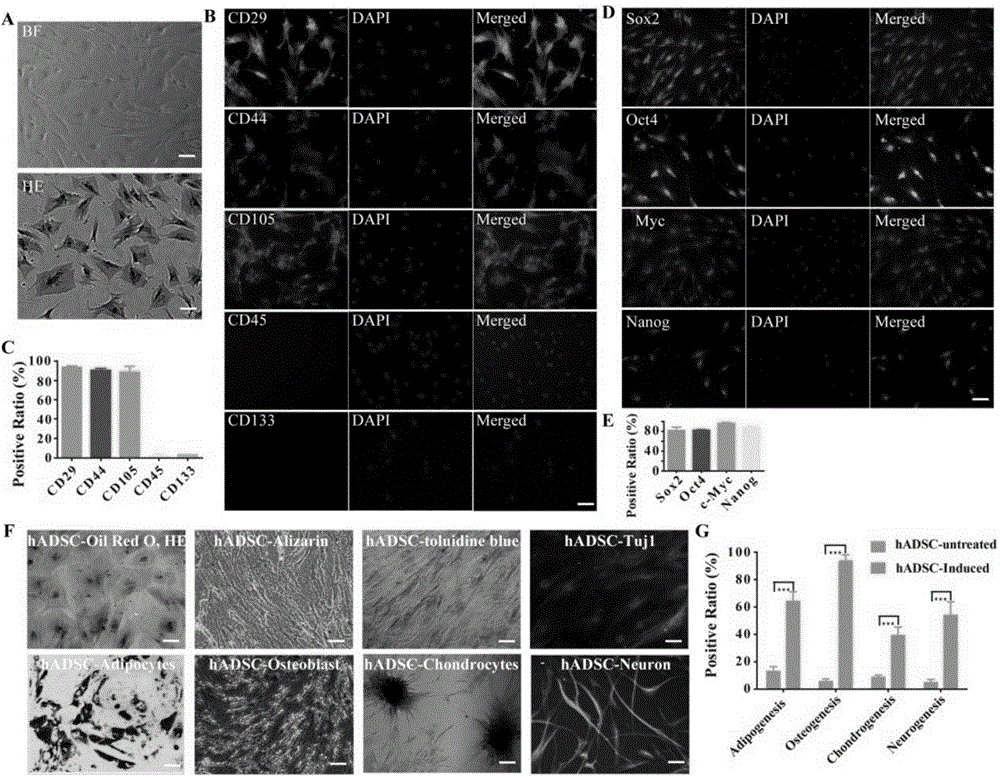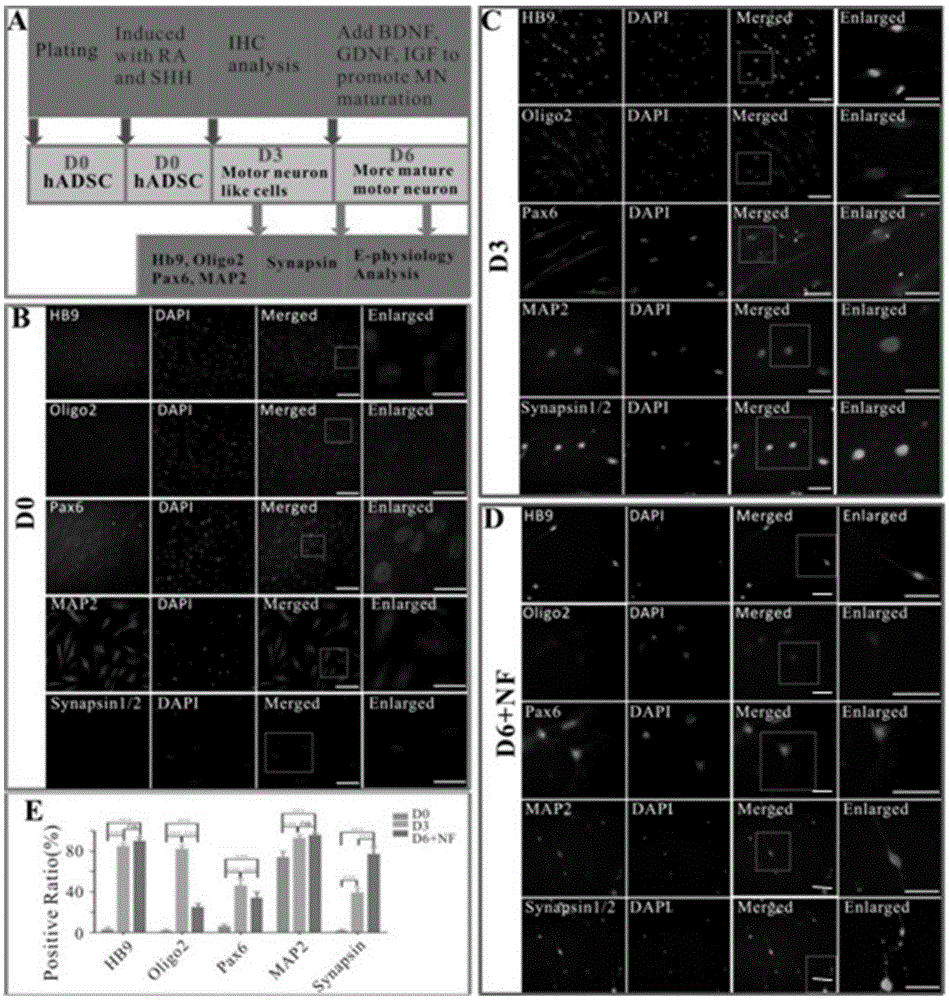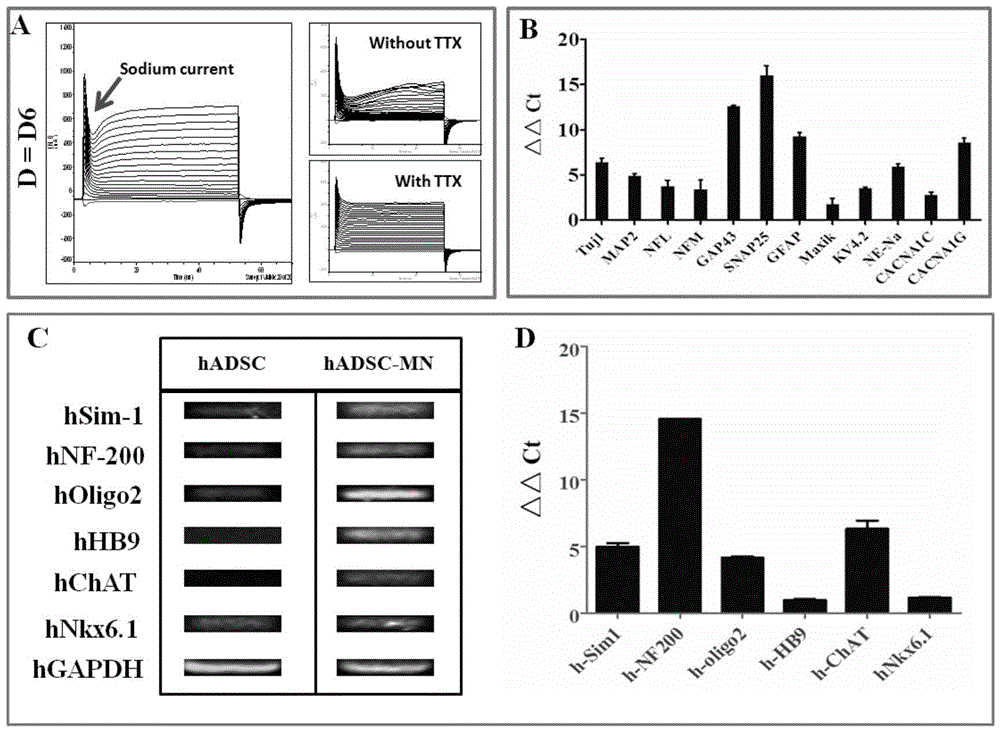Motoneuron-like cells derived from adipose stem cells as well as preparation method and application of motoneuron-like cells
A motor neuron and adipose stem cell technology, applied in the field of stem cells and biomedicine, can solve the problems of motor neuron-like cell curative effect, low maturity and short survival time of motor neuron-like cells.
- Summary
- Abstract
- Description
- Claims
- Application Information
AI Technical Summary
Problems solved by technology
Method used
Image
Examples
Embodiment 1
[0164] Example 1. In vitro isolation, expansion and characterization of human ADSCs
[0165] Human adipose tissue obtained by liposuction was processed and inoculated in T-75 flasks in DMEM / F-12 basal medium containing 10% FBS. The medium was changed twice a week, and after 15 days of culture, adherent hADSCs were enriched, and showed typical spindle-like vortex growth by bright-field microscopic images and hematoxylin and eosin (HE) staining, and with large nucleoli ( figure 1 A). High-purity hADSCs were obtained by serial passage. Purified hADSCs stained positively for the mesenchymal stem cell-specific epitopes CD29, CD44, CD105 for most of the isolated cells (>85%), whereas hematopoietic stem cell-specific markers CD45 and CD133 were negative (figure 1 B and C), which is consistent with previous reports.
[0166] By immunocytochemical staining[10], more than 80% of hADSCs also expressed classical embryonic stem cell markers, such as Sox2, Oct4, c-Myc and Nanog( figure ...
Embodiment 2
[0167] Example 2. Differentiation of hADSCs into electrophysiologically active motor neuron-like cells
[0168] It has been reported that SHH and RA are important for the neutralization and ventralization of ESCs or iPSCs, which contribute to the differentiation from pluripotent stem cells into motor neurons. Therefore, the inventors examined whether SHH and RA can make hADSC transdifferentiate into motor neurons ( figure 2 A). Before induction, most hADSCs (>95%) were negative for neuronal markers MAP2 and synapsin1 and motor neuron marker HB9, except for a small amount of faint and diffuse MAP2 staining ( figure 2 B), suggesting that without induction, spontaneous neuronal differentiation is minimal and hADSCs can maintain their stem cell identity even after a series of passages. The inventors observed drastic morphological changes starting as early as 6 hours after treatment. Surprisingly, within 3 days of induction, the cells began to express the motor neuron markers ...
Embodiment 3
[0170] Example 3. The curative effect of transplanted hADSC-preMN in mouse spinal cord injury model
[0171] The inventors further examined whether hADSC-derived motoneurons could exert therapeutic effects in the SCI model in vivo.
[0172] hADSCs were first treated with SHH and RA for one day. After testing, 60% of the obtained cell population expressed the motor neuron progenitor cell marker Oligo2; 40% of the cells expressed the motor neuron progenitor cell marker PAX6; 70% of the cells expressed the motor neuron cell marker HB9; 80% of the cells expressed the neuronal cell marker MAP2. These preconditioned cells were then selected and transplanted into the injured part of the spine and its outer center in spinal cord-injured mice. Three days before transplantation, hADSCs were infected with lentivirus-GFP in order to trace the transplanted cells. Cell transplantation was performed on the 7th day after the establishment of the SCI model. The mice were then maintained in...
PUM
 Login to View More
Login to View More Abstract
Description
Claims
Application Information
 Login to View More
Login to View More - R&D
- Intellectual Property
- Life Sciences
- Materials
- Tech Scout
- Unparalleled Data Quality
- Higher Quality Content
- 60% Fewer Hallucinations
Browse by: Latest US Patents, China's latest patents, Technical Efficacy Thesaurus, Application Domain, Technology Topic, Popular Technical Reports.
© 2025 PatSnap. All rights reserved.Legal|Privacy policy|Modern Slavery Act Transparency Statement|Sitemap|About US| Contact US: help@patsnap.com



